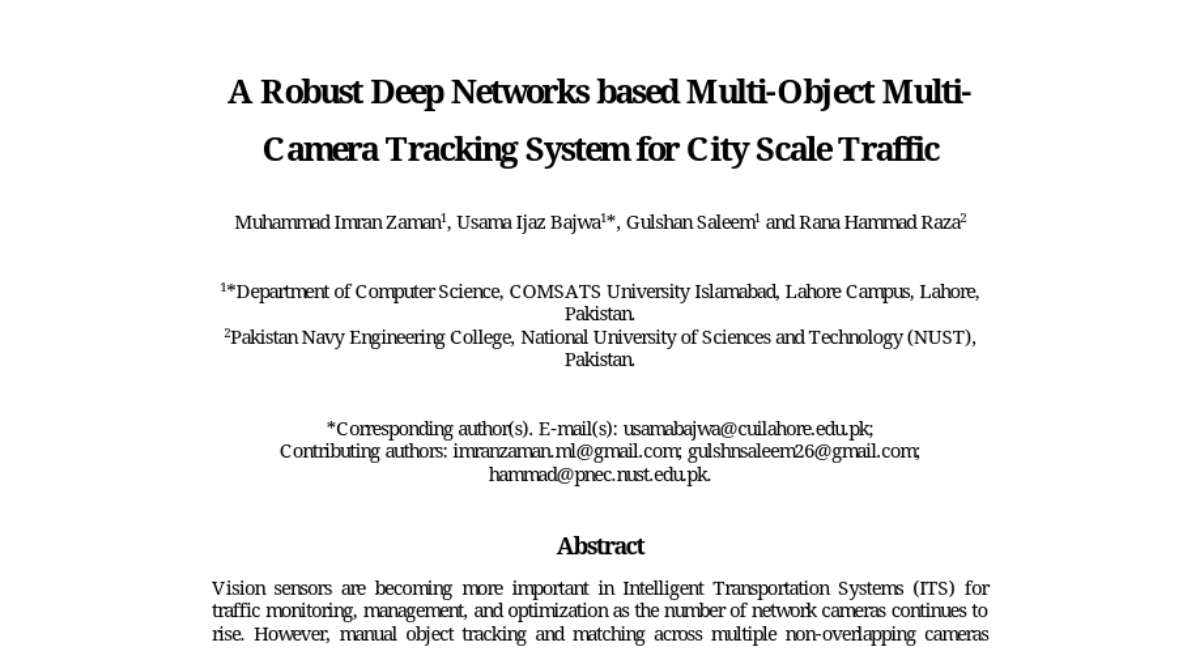AI Native Daily Paper Digest – 20250502
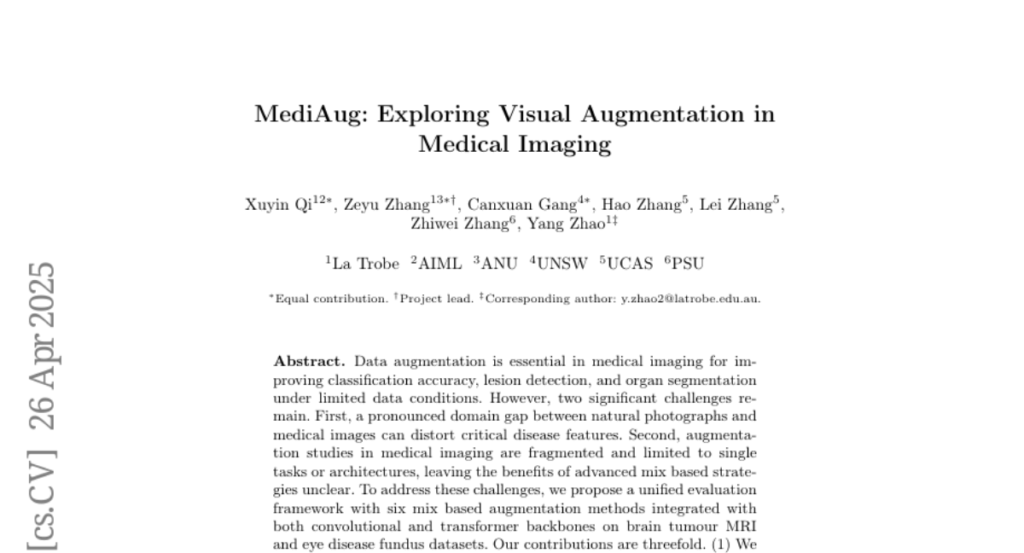
1. A Survey of Interactive Generative Video
🔑 Keywords: Interactive Generative Video, generative capabilities, interactive features, control signals, responsive feedback
💡 Category: Generative Models
🌟 Research Objective:
– To define Interactive Generative Video (IGV) and explore its applications in gaming, embodied AI, and autonomous driving.
🛠️ Research Methods:
– A comprehensive framework proposed, decomposing an IGV system into five modules: Generation, Control, Memory, Dynamics, and Intelligence.
– Systematic analysis of technical challenges and future directions for each IGV component.
💬 Research Conclusions:
– The research facilitates future IGV development by addressing real-time generation, open-domain control, long-term coherence, accurate physics simulation, and causal reasoning.
👉 Paper link: https://huggingface.co/papers/2504.21853
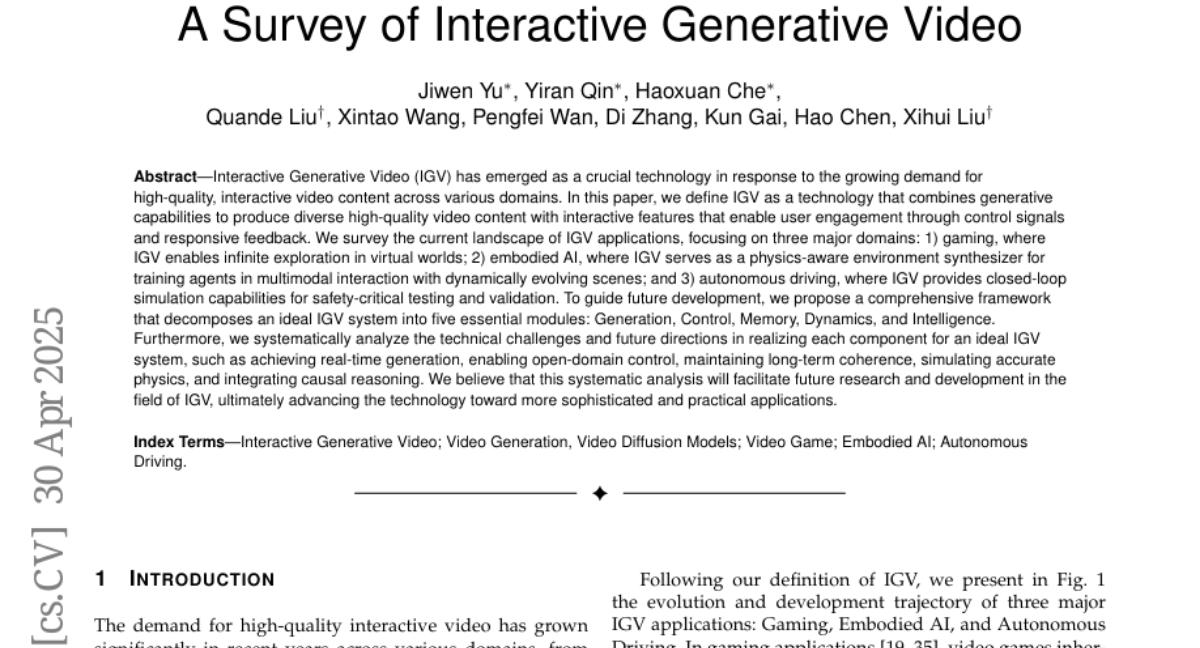
2. DeepCritic: Deliberate Critique with Large Language Models
🔑 Keywords: Large Language Models (LLMs), critique models, automated supervision, reinforcement learning, Monte Carlo sampling-based correctness estimation
💡 Category: Natural Language Processing
🌟 Research Objective:
– The study aims to enhance the math critique ability of Large Language Models (LLMs) by developing a two-stage framework for more effective critiquing of math solutions.
🛠️ Research Methods:
– A novel two-stage framework is proposed, involving the use of Qwen2.5-72B-Instruct to generate deliberate step-wise critiques as seed data for supervised fine-tuning, followed by reinforcement learning using either existing human-labeled data or automatically annotated data via Monte Carlo sampling.
💬 Research Conclusions:
– The developed critique model built on Qwen2.5-7B-Instruct significantly outperforms existing LLM critics on error identification benchmarks and provides more detailed feedback to improve the LLM generator’s corrections of erroneous steps.
👉 Paper link: https://huggingface.co/papers/2505.00662
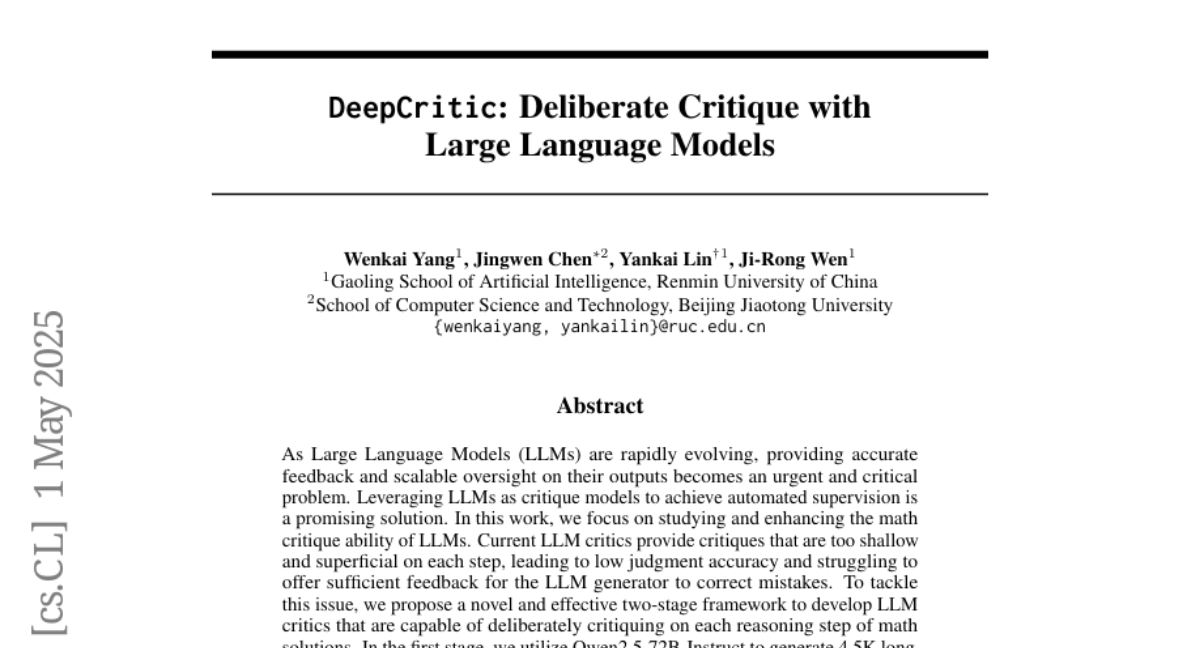
3. T2I-R1: Reinforcing Image Generation with Collaborative Semantic-level and Token-level CoT
🔑 Keywords: chain-of-thought (CoT), reinforcement learning (RL), text-to-image generation model, semantic-level CoT, token-level CoT
💡 Category: Generative Models
🌟 Research Objective:
– Introduce T2I-R1, a novel reasoning-enhanced text-to-image generation model that applies reinforcement learning in the visual generation domain using a bi-level CoT reasoning process.
🛠️ Research Methods:
– Implement two levels of CoT: semantic-level for planning and token-level for pixel processing, coordinated through BiCoT-GRPO, to optimize both generation CoTs in the same training step with ensemble generation rewards.
💬 Research Conclusions:
– T2I-R1 demonstrates superior performance, with a 13% improvement on T2I-CompBench and 19% on the WISE benchmark, surpassing the state-of-the-art model FLUX.
👉 Paper link: https://huggingface.co/papers/2505.00703
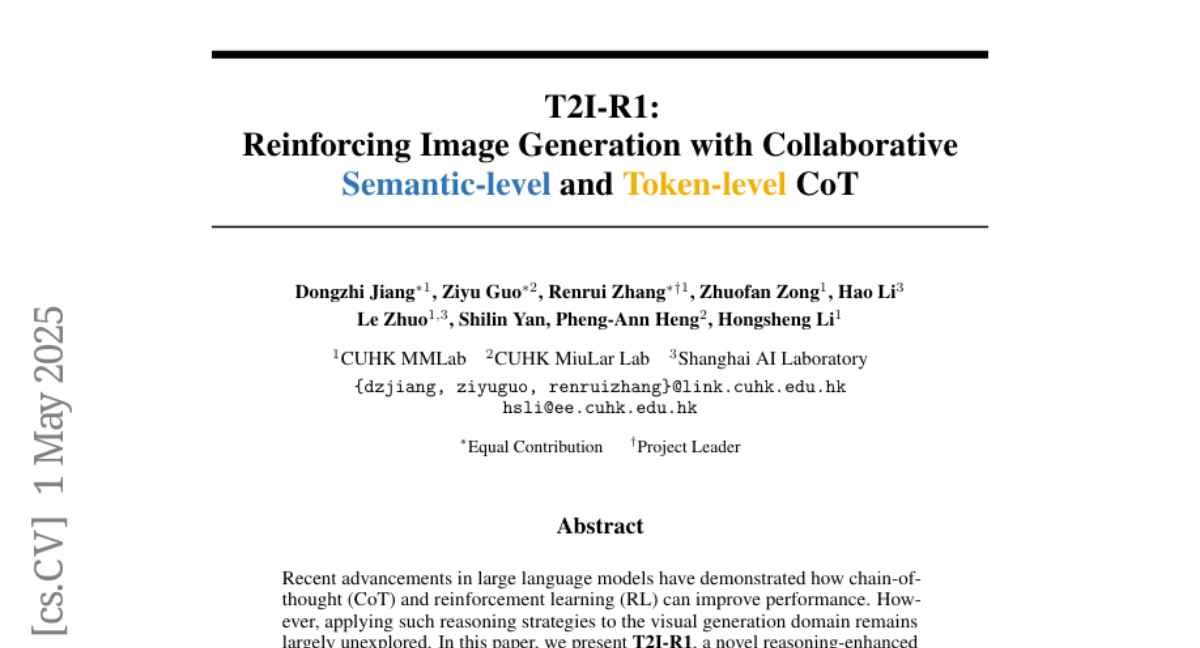
4. Self-Generated In-Context Examples Improve LLM Agents for Sequential Decision-Making Tasks
🔑 Keywords: Large Language Model, in-context examples, self-generated examples, successful trajectories, population-based training
💡 Category: Natural Language Processing
🌟 Research Objective:
– To explore how Large Language Model agents can automatically enhance their performance in sequential decision-making tasks by learning from self-generated successful experiences instead of relying on task-specific knowledge engineering.
🛠️ Research Methods:
– The construction and refinement of a database of self-generated examples, with extensions involving database-level and exemplar-level selection using population-based training.
💬 Research Conclusions:
– The study demonstrates that leveraging self-generated successful trajectories can significantly improve test performance across benchmarks, offering an effective alternative to traditional knowledge engineering.
👉 Paper link: https://huggingface.co/papers/2505.00234
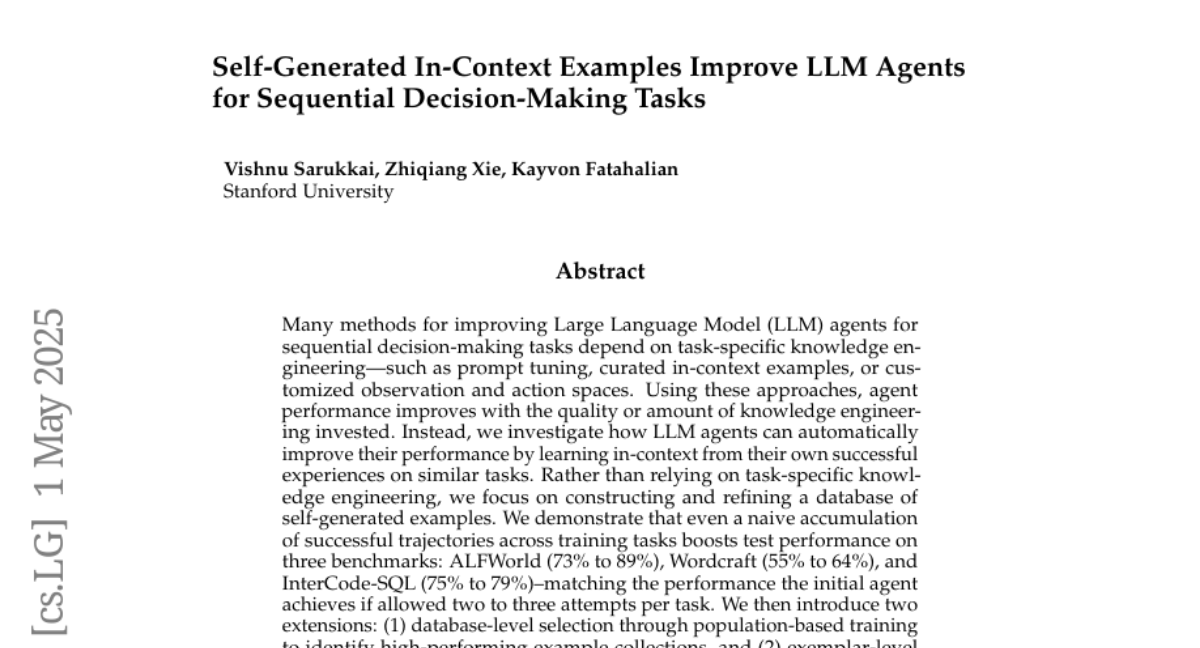
5. KeySync: A Robust Approach for Leakage-free Lip Synchronization in High Resolution
🔑 Keywords: Lip synchronization, Temporal consistency, Expression leakage, Facial occlusions, KeySync
💡 Category: Computer Vision
🌟 Research Objective:
– The research aims to address challenges in lip synchronization, specifically temporal consistency, expression leakage, and facial occlusions commonly found in real-world applications like automated dubbing.
🛠️ Research Methods:
– The proposed two-stage framework, KeySync, introduces a carefully designed masking strategy to solve temporal consistency and manage expression leakage and occlusions.
💬 Research Conclusions:
– KeySync achieves state-of-the-art results in lip reconstruction and cross-synchronization, improving visual quality while reducing expression leakage and facial occlusions. Effectiveness is validated through several ablation studies.
👉 Paper link: https://huggingface.co/papers/2505.00497
6. LLMs for Engineering: Teaching Models to Design High Powered Rockets
🔑 Keywords: Large Language Models, RocketBench, precision landing challenges, reinforcement learning, 7B parameter model
💡 Category: Reinforcement Learning
🌟 Research Objective:
– Evaluate the capabilities of Large Language Models (LLMs) in high-powered rocketry design through a benchmark called RocketBench.
🛠️ Research Methods:
– Tested LLMs on tasks like target altitude optimization and precision landing challenges to assess performance against human experts, and used reinforcement learning to enhance LLM performance.
💬 Research Conclusions:
– While state-of-the-art LLMs show strong engineering knowledge, they struggle to improve design based on simulations. However, reinforcement learning enables a 7B parameter model to outperform both foundational models and human experts, indicating potential for broader engineering applications.
👉 Paper link: https://huggingface.co/papers/2504.19394
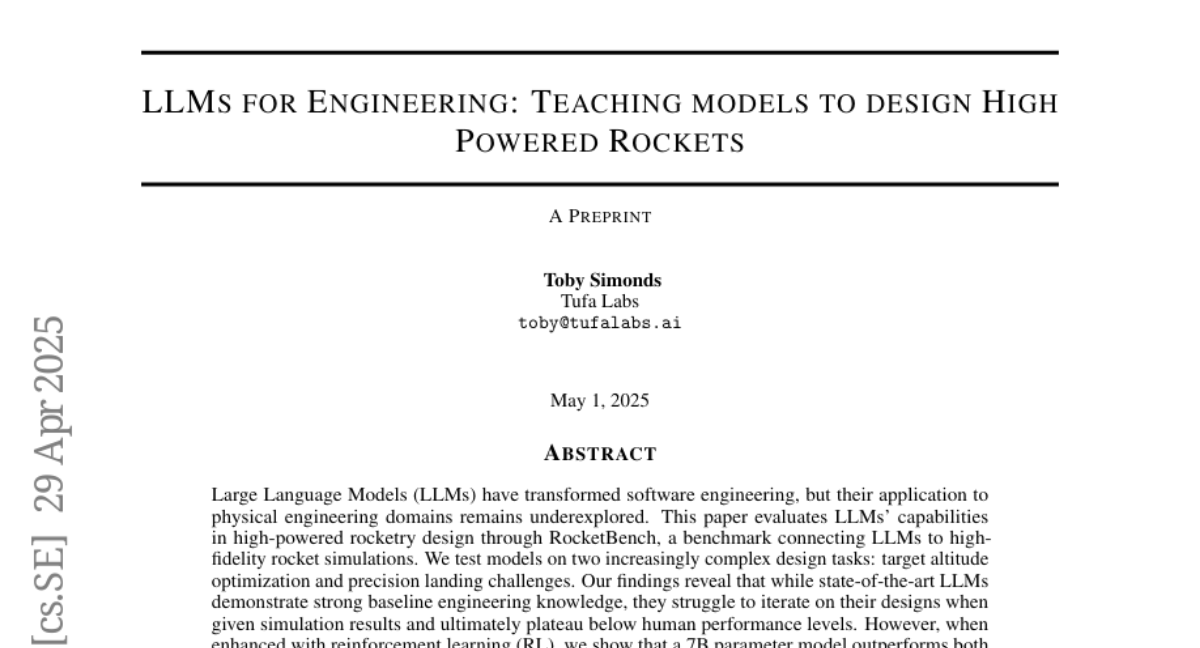
7. TF1-EN-3M: Three Million Synthetic Moral Fables for Training Small, Open Language Models
🔑 Keywords: instruction-tuned models, combinatorial prompt engine, moral storytelling, GPT-based critic, child-friendly educational AI
💡 Category: AI in Education
🌟 Research Objective:
– The research aimed to create a large, structured corpus of moral stories in English that couples coherent narratives with explicit ethical lessons, using instruction-tuned models.
🛠️ Research Methods:
– The authors employed a combinatorial prompt engine to guarantee genre fidelity and a hybrid evaluation pipeline that includes a GPT-based critic for assessing grammar, creativity, moral clarity, template adherence, and diversity metrics.
💬 Research Conclusions:
– The study presents TF1-EN-3M, a dataset of three million English-language fables. The Llama-3 variant model proved effective in quality-speed trade-off. The dataset and associated resources are released under a permissive license, offering opportunities for further research in narrative intelligence and educational AI.
👉 Paper link: https://huggingface.co/papers/2504.20605
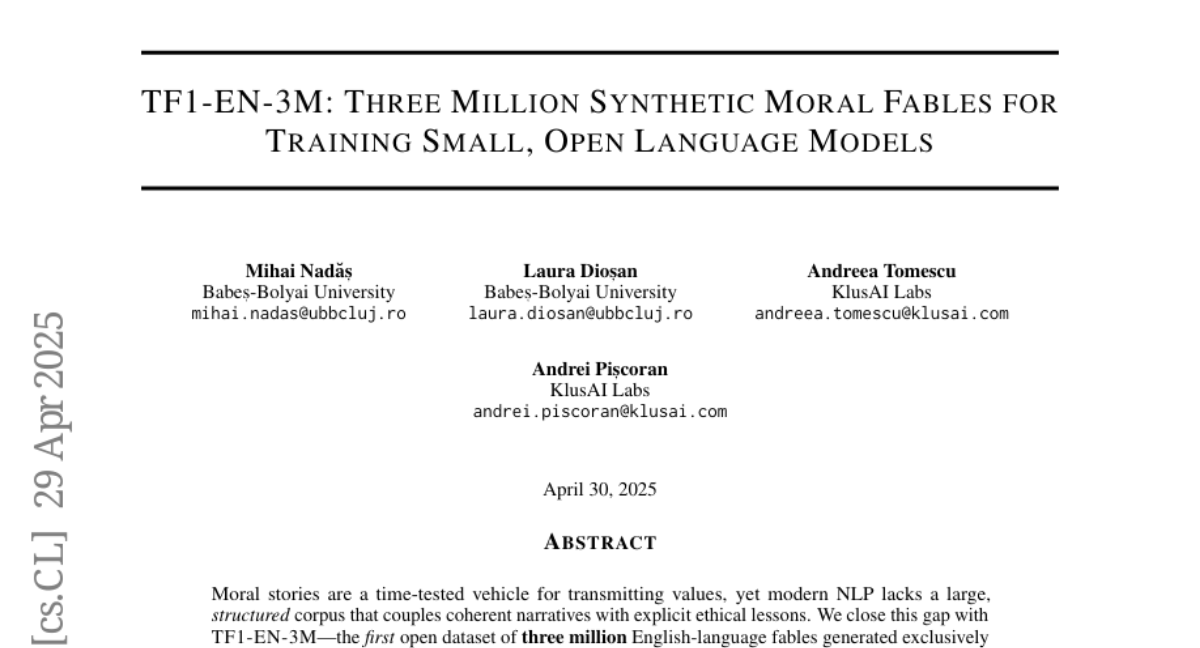
8. MediAug: Exploring Visual Augmentation in Medical Imaging
🔑 Keywords: Data Augmentation, Medical Imaging, Domain Gap, MixUp, ResNet-50, ViT-B
💡 Category: AI in Healthcare
🌟 Research Objective:
– Address challenges in data augmentation for medical imaging, specifically domain gaps and fragmented methodologies.
🛠️ Research Methods:
– Introduced MediAug, a unified evaluation framework incorporating six mix-based augmentation methods with convolutional and transformer backbones on brain tumor MRI and eye disease fundus datasets.
💬 Research Conclusions:
– MixUp significantly improves brain tumor classification with 79.19% accuracy on ResNet-50, and SnapMix achieves 99.44% accuracy on ViT-B. For eye disease classification, YOCO enhances performance to 91.60% on ResNet-50, and CutMix increases accuracy to 97.94% on ViT-B.
👉 Paper link: https://huggingface.co/papers/2504.18983
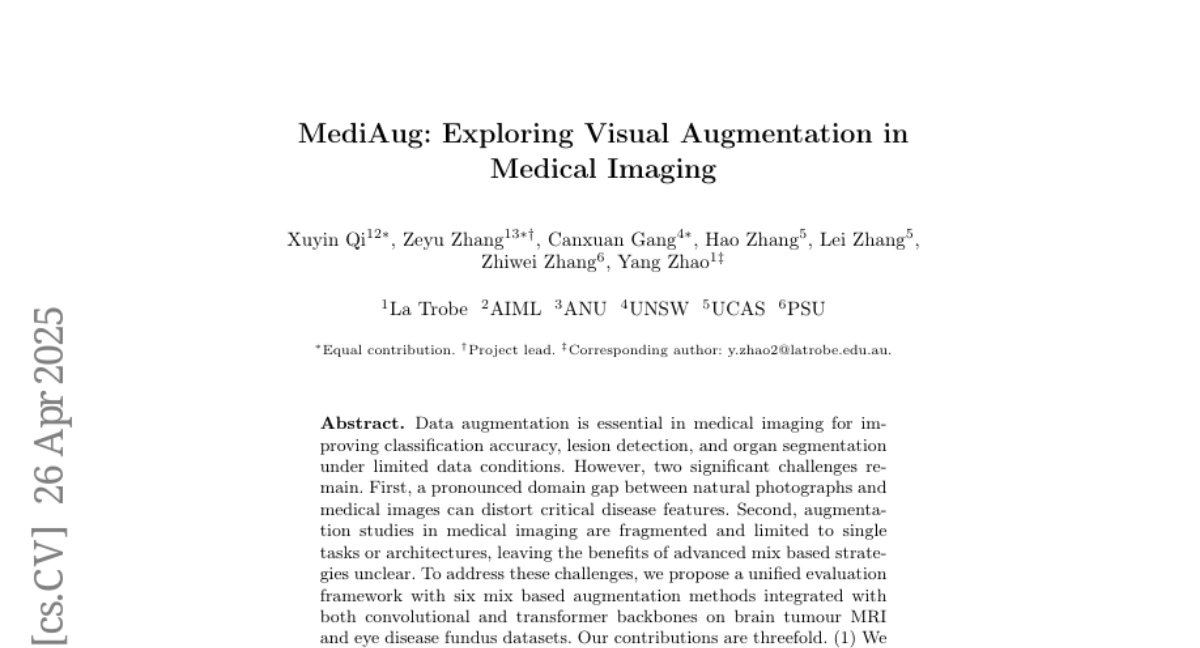
9. AdaR1: From Long-CoT to Hybrid-CoT via Bi-Level Adaptive Reasoning Optimization
🔑 Keywords: adaptive reasoning strategies, Long-CoT, hybrid reasoning model, bi-level preference training, inference costs
💡 Category: Knowledge Representation and Reasoning
🌟 Research Objective:
– To propose a novel two-stage framework for adaptive and efficient reasoning in long and short chain-of-thought (CoT) models.
🛠️ Research Methods:
– Merging long and short CoT models to create a hybrid reasoning model, along with bi-level preference training to guide the selection of suitable reasoning styles.
💬 Research Conclusions:
– The proposed method significantly reduces inference costs while maintaining performance, with an over 50% reduction in the average length of reasoning on five mathematical datasets.
👉 Paper link: https://huggingface.co/papers/2504.21659
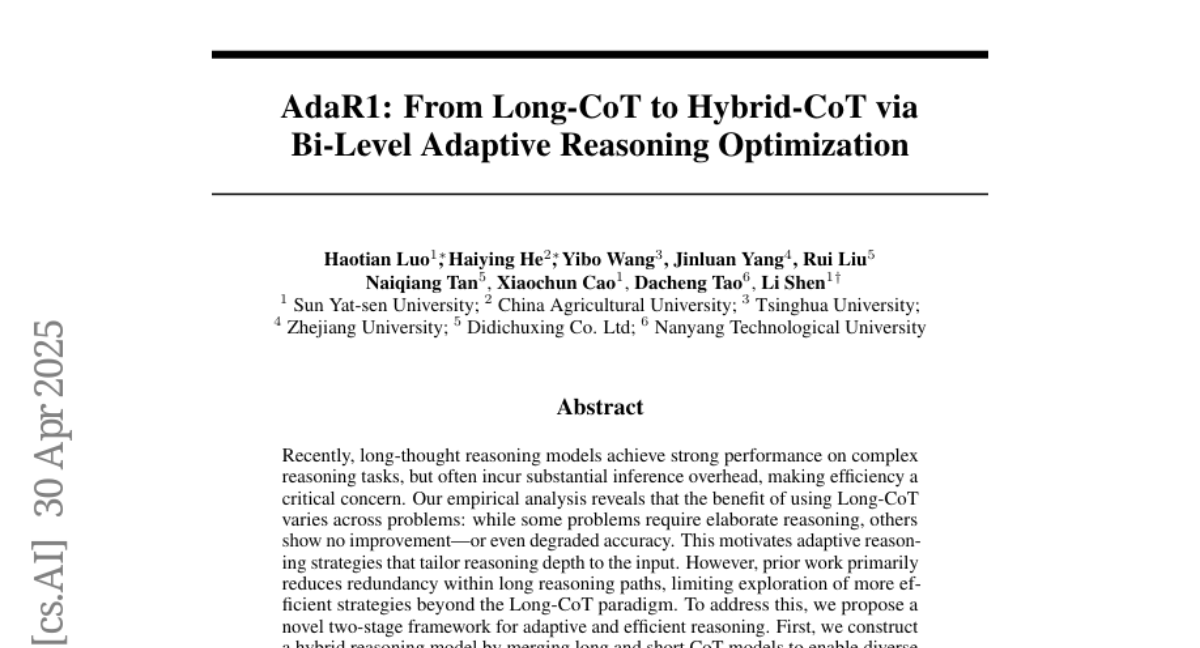
10. Spatial Speech Translation: Translating Across Space With Binaural Hearables
🔑 Keywords: spatial speech translation, real-time expressive translation, binaural rendering, blind source separation, BLEU score
💡 Category: Natural Language Processing
🌟 Research Objective:
– To introduce and develop a system for spatial speech translation that translates multiple speakers in the environment while maintaining spatial audio cues.
🛠️ Research Methods:
– The study addresses technical challenges related to blind source separation, localization, real-time expressive translation, and binaural rendering to achieve effective real-time translation on the Apple M2 silicon.
💬 Research Conclusions:
– The developed prototype binaural headset successfully translates speech with a BLEU score of up to 22.01 amid strong interference and is proven effective in spatially rendering translation in real-world reverberant environments according to user studies.
👉 Paper link: https://huggingface.co/papers/2504.18715
11. Skill Discovery for Software Scripting Automation via Offline Simulations with LLMs
🔑 Keywords: Large Language Models, verified scripts, Graph Neural Network, automation success rates
💡 Category: AI Systems and Tools
🌟 Research Objective:
– This research aims to bridge the gap between users without programming expertise and the ability to automate tasks using scripting interfaces by developing an offline simulation framework.
🛠️ Research Methods:
– The study proposes a framework comprising task creation through top-down functionality guidance and bottom-up API synergy exploration, coupled with skill generation and validation with trials.
💬 Research Conclusions:
– The framework improves automation success rates, reduces response time, and decreases runtime token costs when compared to traditional runtime code generation methods, offering insights into aligning AI capabilities with user needs.
👉 Paper link: https://huggingface.co/papers/2504.20406
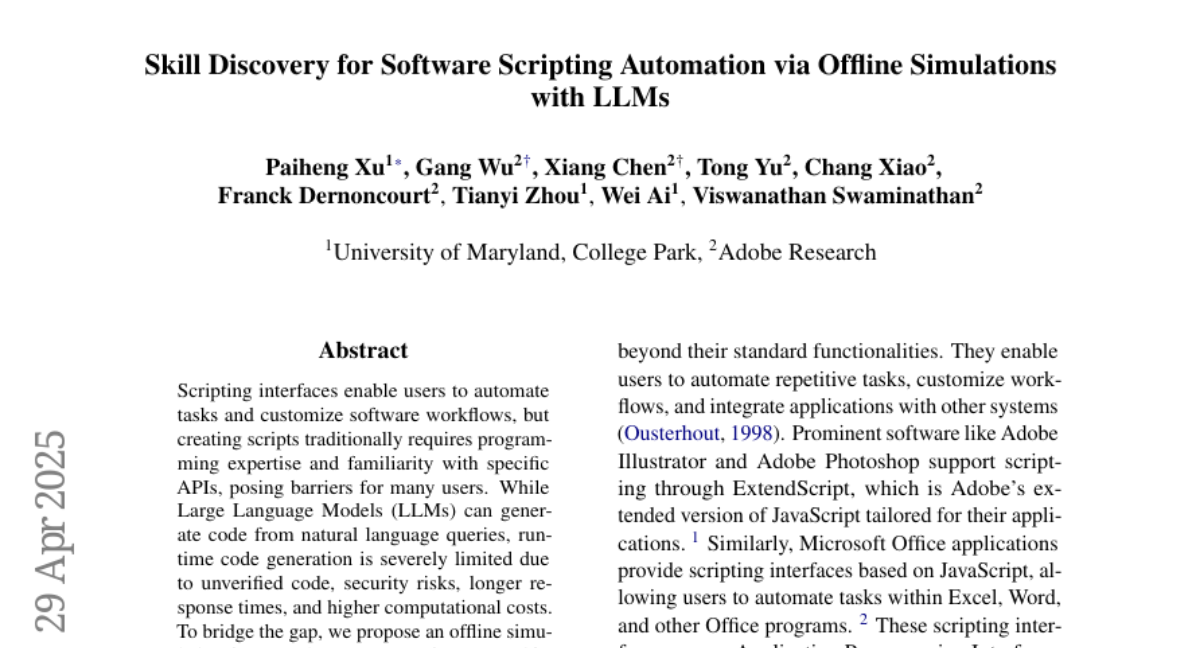
12. A Robust Deep Networks based Multi-Object MultiCamera Tracking System for City Scale Traffic
🔑 Keywords: Vision sensors, Multi-Object Multi-Camera Tracking, Deep learning, Mask R-CNN, Transfer learning
💡 Category: Computer Vision
🌟 Research Objective:
– To address the challenges of manual object tracking and matching in Intelligent Transportation Systems for urban traffic scenarios using a deep learning-based framework.
🛠️ Research Methods:
– Utilization of Mask R-CNN for object detection and Non-Maximum Suppression to select target objects; Transfer learning for re-identification; Feature extraction using ResNet-152 coupled with Deep SORT for vehicle tracking.
💬 Research Conclusions:
– The deep learning-based framework demonstrates its effectiveness with competitive performance in vehicle tracking, achieving an IDF1 score of 0.8289, and high precision and recall rates on the AI City Challenge dataset.
👉 Paper link: https://huggingface.co/papers/2505.00534
